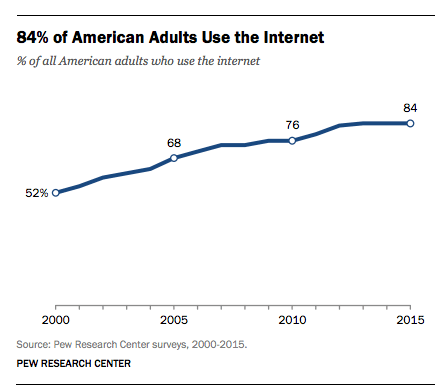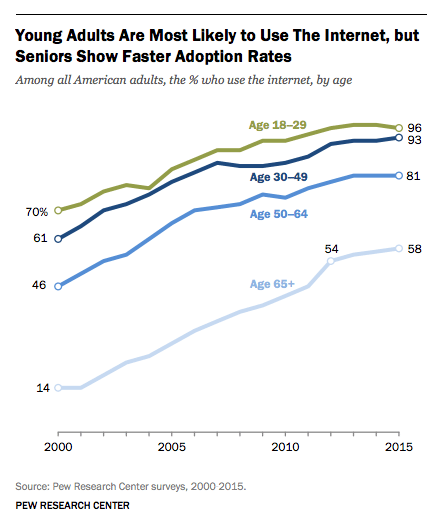There has been a tendency in the U.S. to believe the internet provides significant access to citizens but that leaves out many, especially the old and the low income. But as shown by the latest survey of Pew Research Center’s American’s Interest Access: 2000-2015, by Andrew Perris and Maeve Duggan, it effectively becomes a universal source for the public.
There are some important limits to the Pew Center. The survey method lets participants divine their own ideas of contact. The methods allowed since 2013 allows either at least occasional internet or email contact, or contact through a cell phone, tablet, or other mobile device. There is no specific quality on access speed required.
Between 2000 and 2015, the percentage of internet access has gone from a bare majority, 52%, to a near complete share, 84%:

But more significant is what we see on an age basis, with rapid convergence since 2000. Participants 18-49 are, for all practical purposes, totally covered, and 50-64 are not that far away. Only those over 65 fall short.

Internet access based on education is a bit different Over the pass 15 years, college graduates and those with some college closed in to almost complete internet access. High school graduates came along pretty well, from 40% to 76%. The remarkable group, though, is less than high school graduates, who were moved from an almost absent 19% in 2000 to a much more common 66% this year.
The pattern of income has been very similar: Almost total coverage for the top income groups, a close follow in the $40-49,999 middle group, and fast growth to 74% among the low income group. “These trends have been consistent over time, although the more recent rise of smartphones has provided internet access to lower income people, sometimes with lower prices, sometimes with other attractive technology features,” says Pew Research. “Indeed, a recent report released by Pew Research found that lower-income Americans are increasingly ‘smartphone-dependent’ for internet access.”
Another area of promising response is pretty much uniform internet access by race or language style. English Asian speakers do show a leading pattern of 97%. Others–white, black, and Hispanic–have closed in to virtually no difference.

There were two groups that had virtually no split in internet access. Urban-suburban-rural coverage went from 56%-53%-42% to 85%-85%-78%. Lower rural results, the study finds, is more a factor of higher age among the rural population than any other issue. And there is virtually no difference between genders, going from 54%-50% in 2000 to 85%-84% now.
I wish we had more information on the difference among some of the groups, particularly issues such as the speed and access based on age and payment, how much the service is used, say, every week, and how many people were dependent on smartphones for access–or perhaps getting just email, which can be a category. But whatever the shortcomings, the findings of the Pew Center is a useful sign of how important at least minimal access to the internet is to citizens of any age or background.

What surprises me is the .. AOLization of the Internet ?
Non-techie users around me are increasingly, and to surprising degrees, seeing the Internet only through the lens of proprietary apps and services. They’re using Twitter and Facebook to follow content that has been available on RSS/Atom for over a decade, getting locked into gmail’s tags when they could use a (small) handful of IMAP folders, using messaging apps when texts work better (not a lot of emoticons…). Well, that last one is not Internet, but it fits the “standard vs proprietary” theme.
I’m probably getting old. I’m wondering how bad the hangover will be when users realize they’re locked in on a scale that even Microsoft couldn’t dream of ?
This is becoming true even of Google. Google is the most visited web property in every major geography I survey. If the allegations are correct brought out by this yelp suit about them manipulating search results, then most people aren’t even experiencing the open web but the closed web.
Now, most poeple are lazy and probably don’t care so long as they get what they want or need, but still it is interesting to think about.
A good number of people I know… google URLs. They have the full URL, but instead of typing it in the adress bar, they put it into Goggle’s searchbox, which is their home.
The only way Google is a bit less evil is their Takeout service, which does export most stuff (contacts, mails, calendar…) in a standard format in one click.
This is my first time pay a quick visit at here and i am really happy to read everthing at one place